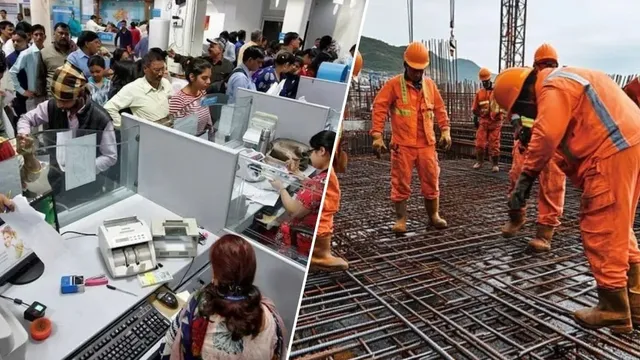- By Akansha Pandey
- Sat, 22 Nov 2025 09:44 AM (IST)
- Source:JND
The Central Government has executed the largest and most significant shift in labor reforms to date. The Modi government has abolished 29 labor-related laws, replacing them with four new labor reform laws implemented across the country starting November 21. The government has stated that this will be a major step toward an Atmanirbhar Bharat (Self-reliant India).
These changes initiated by the Center are expected to play a crucial role in the country's employment and industrial systems. The new labor laws will provide social security coverage to approximately 40 crore workers. This implies that, for the first time, more than half of the nation's workforce has been brought under a safety net.
The Government has streamlined the regulatory framework by amalgamating 29 distinct labor laws into four unified Labour Codes:
- The Code on Wages (2019),
- The Industrial Relations Code (2020),
- The Code on Social Security (2020),
- The OSH Code (2020).
This landmark reform simplifies compliance and reinforces worker rights, ensuring greater access to security, dignity, and welfare while establishing a robust, future-ready industrial ecosystem.
Here are the key highlights of the four new Labor Codes implemented in the country:
Key Features Of The New Labor Laws
1. Modernisation of Archaic Laws: Currently, the labor laws in force are quite old, dating back to the period between 1930 and 1950. It has long been believed that these old laws did not adequately address economic interests. Furthermore, outdated laws did not include modern terminology such as "Gig Workers," "Platform Work," or "Migrant Laborers." With the implementation of the new codes, 29 old labor laws have been repealed.
2. Mandatory Appointment Letters and Minimum Wage: According to the new labor laws effective from November 21:
- It is now mandatory to issue an appointment letter to every employee.
- The scope of minimum wage will be expanded to cover all workers.
- There is a legal provision for the timely payment of salaries.
- The government argues that these laws will increase transparency regarding employment conditions. The objective of a nationwide minimum wage is to ensure that no one’s salary is so low that they cannot sustain a livelihood.
3. Recognition of Gig and Platform Workers
Definitions: Terms like ‘Platform Work,’ ‘Gig Work,’ and ‘Aggregators’ have been defined in the labor codes for the first time.
Social Security: Provisions have been made to provide social security to all gig workers. To fund this, aggregators will be required to contribute 1 per cent to 2 per cent of their annual turnover.
Fixed-Term Employees: Fixed-term employees will now be entitled to the same salary, leave, medical benefits, and social security as permanent employees. Additionally, they will be eligible for gratuity after just one year of service, rather than the previous requirement of five years.
4. Inclusion of New Sectors: The new labor codes now cover a wider range of professions to ensure they receive benefits, including:
- Plantation workers.
- Journalists in audio-visual, digital, and electronic media.
- Dubbing artists and stunt persons.
5. Safety Standards and IT Sector Regulations
Hazardous Industries: Standards for on-site safety monitoring and social security have been set for workers in hazardous industries, including mine workers.
IT and Exports: Workers in the textile industry, IT & ITES sectors, ports, and export zones have been brought under this ambit.
Payment & Leave: Employers in these sectors must mandatory pay salaries by the 7th of every month. Furthermore, employees will now be entitled to annual leave after working for 180 days in a year.
6. Ease of Compliance and Dispute Resolution
Dispute Resolution: The code emphasizes the rapid resolution of disputes. It establishes two-member industrial tribunals, with the option to approach the tribunal directly after conciliation efforts.
Simplified Filing: For companies, "Single Registration, Single License, and Single Return" will replace multiple overlapping filings.
Safety Boards: A National OSH (Occupational Safety and Health) Board will set uniform safety and health standards across all sectors.
Committees: Establishments with more than 500 workers must have mandatory safety committees to improve accountability, while the regulatory burden on smaller units will be reduced.
The government has clearly stated that existing labor laws were creating obstacles and failing to keep pace with the changing economy and evolving employment methods. The new Labor Codes aim to strengthen both workers and companies, creating a workforce that is safe, productive, and adaptable to the changing world of work.
Union Minister Mansukh Mandaviya tweets, "From today, new Labour Codes have come into effect across the country, ensuring the guarantee of minimum wages on time for all workers, guarantee of appointment letters for the youth, guarantee of social security for 40 crore workers,… pic.twitter.com/diIti2o75Q
— ANI (@ANI) November 21, 2025

